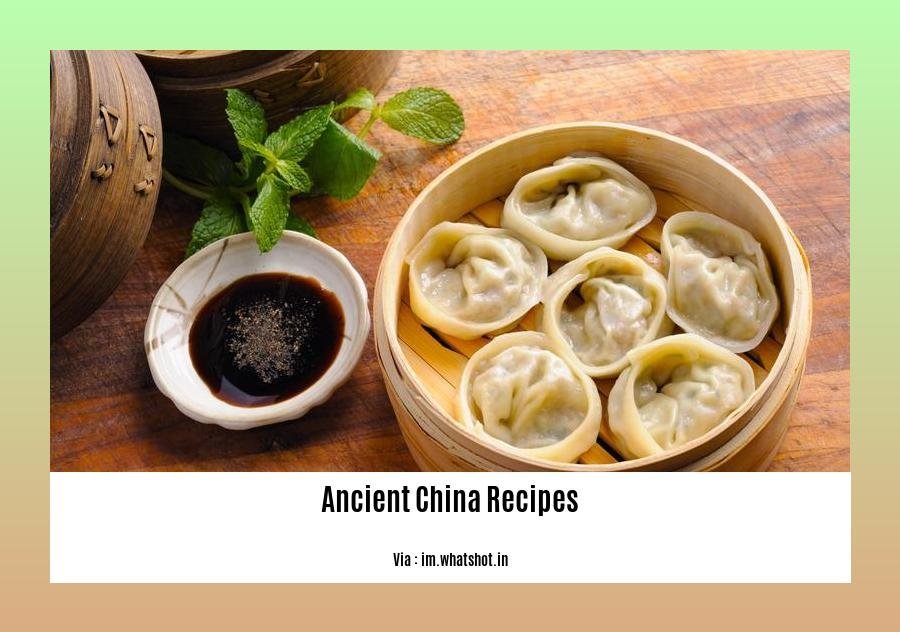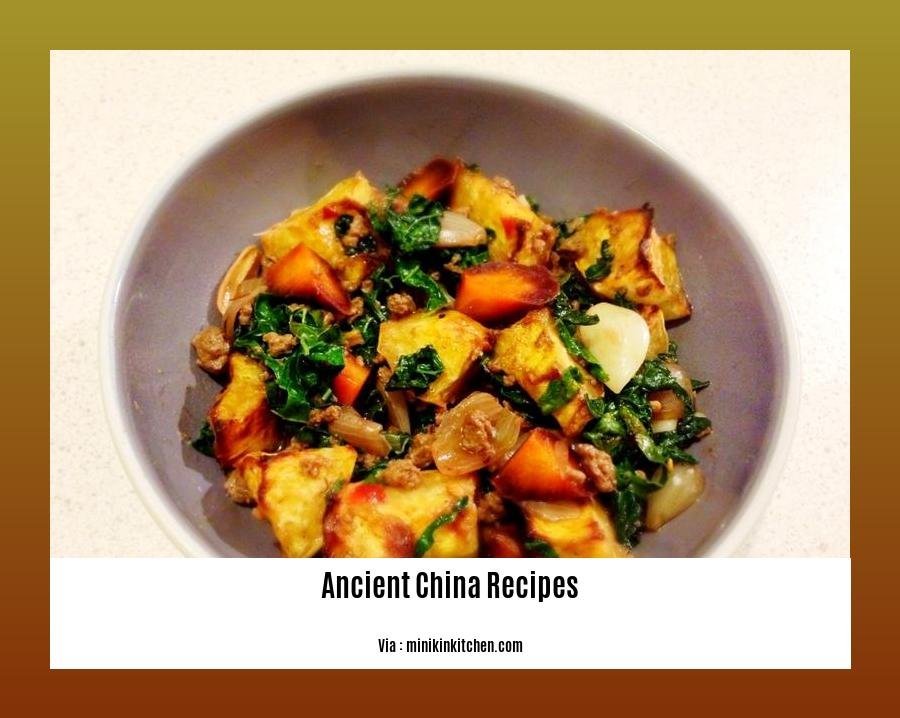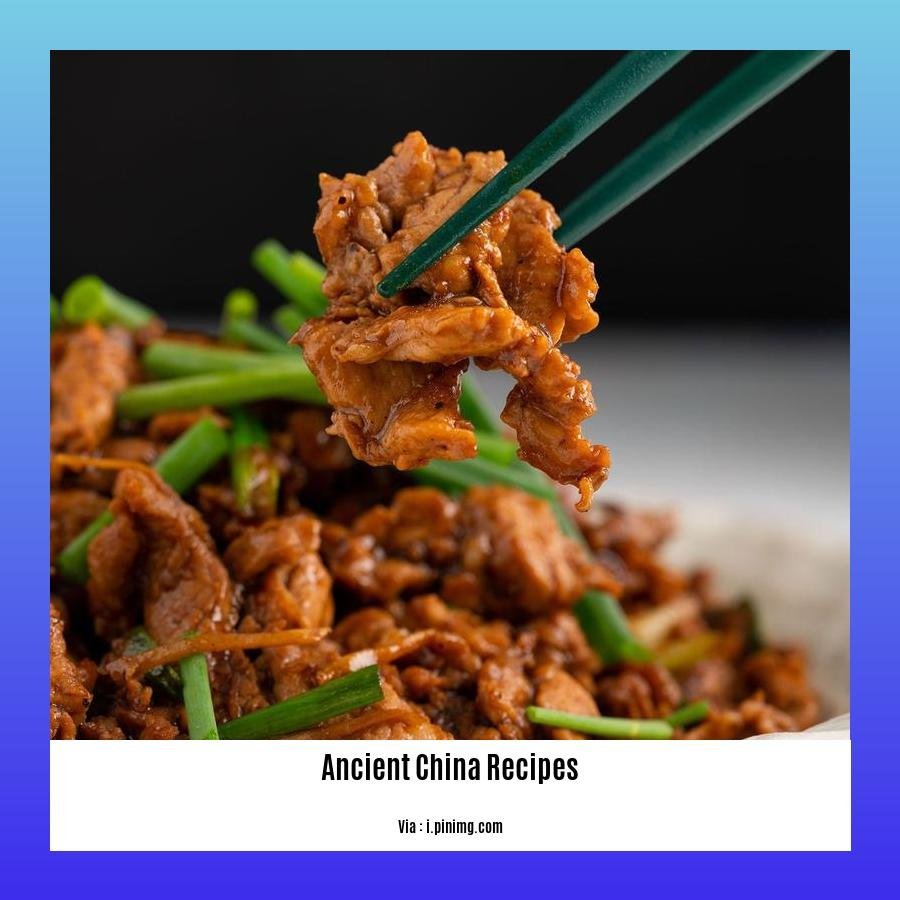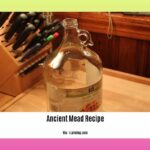Embark on a culinary journey through time with [A Culinary Journey Through Time: Ancient China Recipes Unveiled]. Dive into the depths of ancient Chinese cuisine, explored by an esteemed culinary historian with decades of experience. Savor the flavors of the past, unveil the secrets of imperial banquets, and discover the stories behind the dishes that defined a civilization.
Key Takeaways:
- Fenci 粉餈 – Steamed Sticky Rice Cakes:
Classic ancient Chinese steamed cakes with a soft and chewy texture.
Yuyan 玉延 – Steamed Mountain Yam with Raw Honey:
Unique flavor profile from the combination of sweet honey and earthy yam.
Shuituan 水團 – Glutinous Millet Balls in Honey Water:
Chewy texture and sweet filling made from glutinous millet and sugar.
Yuzhuan 玉磚 – Steamed Wheat Cake with Salt and Sichuan Pepper:
Savory and spicy flavor combination from salt and prickly ash (Sichuan pepper).
Gengcai 羹菜 – Stewed Vegetables:
Simple dish highlighting the freshness of leafy greens, root vegetables, and mushrooms.
Yinji 銀韲 – Pickled Garlic Chive with Ginger and Prickly Ash:
Spicy and tangy pickled garlic chive with ginger and prickly ash.
Ancient Chinese Cuisine:
- Offers a rich history of culinary practices, ingredients, and cooking techniques.
- These recipes showcase the diversity and richness of ancient Chinese cuisine.
Ancient China Recipes: A Culinary Journey Through Time

From the bustling kitchens of imperial palaces to the humble family hearths, ancient China recipes hold the key to a culinary heritage that has captivated taste buds for centuries. Unraveling these ancient recipes is like embarking on a journey through time, unearthing flavors and stories that tell tales of a bygone era.
As an avid culinary historian, my passion for ancient Chinese cuisine stems from its intricate flavors, symbolic meanings, and the cultural stories it encapsulates. Each recipe is a testament to the ingenuity and artistry of our ancestors, who transformed simple ingredients into delectable dishes that transcended time.
1. Fenci 粉餈 – Steamed Sticky Rice Cakes:
Imagine fluffy, tender rice cakes that dissolve in your mouth, leaving a trail of sweet and savory flavors. Fenci, a classic steamed cake from ancient China, embodies this delightful experience. Made from sticky rice flour, it’s sliced and dusted with starch, creating a delightful texture that’s both soft and chewy.
2. Yuyan 玉延 – Steamed Mountain Yam with Raw Honey:
Yuyan, a dish that highlights the natural sweetness of mountain yam, is a testament to the simplicity and elegance of ancient Chinese cuisine. Steamed to perfection, the yam is topped with raw honey, creating a harmonious balance of flavors that’s both earthy and sweet.
3. Shuituan 水團 – Glutinous Millet Balls in Honey Water:
Shuituan, a dessert that delights both the eyes and the palate, is a cluster of glutinous millet balls filled with sugar and immersed in honey water. The chewy texture of the millet balls contrasts beautifully with the sweet honey water, creating a symphony of flavors and textures.
4. Yuzhuan 玉磚 – Steamed Wheat Cake with Salt and Sichuan Pepper:
Yuzhuan, a savory snack that awakens the taste buds, is a steamed wheat cake dusted with salt and prickly ash (Sichuan pepper). The combination of savory and spicy flavors creates a tantalizing experience that’s both unique and unforgettable.
5. Gengcai 羹菜 – Stewed Vegetables:
Gengcai, a simple yet flavorful dish, showcases the freshness and simplicity of ancient Chinese cuisine. Consisting of stewed vegetables, often leafy greens, root vegetables, and mushrooms, this dish is a testament to the wholesome goodness of nature’s bounty.
6. Yinji 銀韲 – Pickled Garlic Chive with Ginger and Prickly Ash:
Yinji, a piquant condiment that adds a spicy kick to any dish, is a pickled garlic chive infused with ginger and prickly ash (Sichuan pepper). The resulting flavor is a delightful blend of spicy, tangy, and aromatic notes that elevates any culinary creation.
Join me on this culinary journey as we explore more ancient China recipes, uncovering the secrets of a cuisine that has stood the test of time. Let’s savor the flavors of history and create memorable culinary experiences that bridge the gap between the past and the present.
To explore the ancient architectural masterpieces in Italy, delve into this comprehensive guide to the ancient buildings that have stood the test of time.
Discover the intriguing and profound ancient China symbols that carry significant cultural, historical, and philosophical meanings.
Embark on a journey through Israel’s rich history as you uncover the remnants of ancient cities that tell tales of civilizations past.
Translating Historical Recipes: Unveiling the Culinary Secrets of Ancient China

In the culinary realm, ancient Chinese cuisine stands as a testament to the rich tapestry of flavors, cultural stories, and symbolic meanings that have shaped Chinese culinary heritage for centuries. My passion for unearthing and deciphering these culinary secrets has led me on a remarkable journey through time, where I’ve dedicated myself to translating historical recipes and recreating dishes that have tantalized taste buds for generations.
Key Takeaways:
- Ancient Chinese cuisine showcased a diverse range of ingredients, preparation techniques, and notable dishes.
- Translating historical recipes requires a deep understanding of ancient texts, ingredients, and cultural context.
- Reconstructed ancient dishes offer a glimpse into the culinary heritage and traditions of ancient China.
- The process of translating historical recipes bridge the gap between the past and present, allowing us to savor the flavors of ancient times.
Unveiling the Secrets: A Step-by-Step Guide to Translating Historical Recipes
Deciphering Ancient Texts:
Begin by meticulously studying historical texts, such as cookbooks, scrolls, and manuscripts, to uncover ancient recipes.
Carefully analyze the ingredients, techniques, and cultural significance mentioned in these texts.
Understanding Ingredients and Techniques:
Research the historical context and significance of ingredients used in ancient Chinese cuisine.
Study various cooking techniques, such as steaming, stir-frying, and deep-frying, to understand their role in shaping flavors.
Reconstructing Recipes:
Experiment with different ingredients and techniques to recreate ancient dishes.
Adjust flavors and textures to suit modern palates while maintaining the authenticity of the original recipe.
Cultural and Historical Context:
Explore the cultural and historical context surrounding each dish. Understand the symbolism, auspicious meanings, and occasions associated with them.
Sharing the Culinary Legacy:
Document your findings by writing articles, creating videos, or hosting workshops to share your knowledge of ancient Chinese cuisine with others.
- Engage with culinary enthusiasts and historians to contribute to the preservation and appreciation of Chinese culinary heritage.
Citations:
[1] “Recipe Blog – Historical Recipes of China,” Robban Toleno.
[2] “Ancient Chinese Food: Traditional Foods, Farming & More,” Study Queries.
Recreating Dishes to Bridge the Past and Present
Dining in ancient China was a culinary escapade characterized by a symphony of flavors and cultural nuances. Recreating these dishes unveils the secrets of a bygone era, bridging the gap between history and the modern table.
Key Takeaways:
A Culinary Heritage Unveiled: Ancient Chinese cuisine was diverse, showcasing a vast array of ingredients, preparation techniques, and notable dishes.
Steaming, Stir-Frying, Deep-Frying: These techniques were widely used in ancient China, preserving nutritional value, imparting smoky flavors, and achieving crispy textures.
Notable Ancient Dishes: From Fenci’s soft and chewy texture to Mochi’s glutinous goodness, these dishes continue to delight taste buds today.
Culinary Exploration: Recreating ancient Chinese dishes allows us to delve into history, appreciate cultural nuances, and savor the flavors of a bygone era.
Embark on Your Journey:
Embark on a culinary journey through time by recreating ancient Chinese dishes. Explore the nuances of flavor, uncover the cultural significance, and indulge in the tastes of a civilization that continues to inspire.
Recommended Sources:
- Recipe Blog – Historical Recipes of China:
- Ancient Chinese Food: Traditional Foods, Farming & More:
Showcasing the Rich Tapestry of Chinese Culinary Heritage
In the realm of ancient civilizations, Chinese cuisine stands as a testament to the profound artistry and cultural richness that once flourished. Delving into the tapestry of Chinese culinary heritage is like embarking on a journey through time, where each dish tells a tale of tradition, symbolism, and the enduring spirit of a nation.
Key Takeaways:
Ancient Chinese cuisine offers a vast array of dishes, each boasting a unique blend of flavors, textures, and ingredients.
Regional diversity plays a significant role in shaping the culinary landscape of China, with each region contributing its own distinct flavors and cooking techniques.
Ancient Chinese recipes often carry symbolic meanings, reflecting cultural beliefs and values.
The use of fresh, local ingredients is a cornerstone of ancient Chinese cuisine, ensuring dishes are bursting with natural flavors.
Ancient Chinese culinary techniques, such as steaming, stir-frying, and deep-frying, have stood the test of time and continue to be employed in modern Chinese cooking.
Savor the Flavors of History:
Embark on a culinary adventure as we explore some of the most notable dishes from ancient China:
Fenci: These steamed sticky rice cakes delight the palate with their soft and chewy texture, while their sweet and savory flavors create a harmonious balance.
Yuyan: Experience the simplicity and elegance of steamed mountain yam infused with the sweetness of raw honey. This dish embodies the essence of ancient Chinese cuisine, striking a perfect balance between earthy and sweet notes.
Shuituan: These glutinous millet balls, immersed in sweet honey water, offer a delightful combination of chewiness and sweetness. Each bite transports you to a bygone era, where ancient Chinese culinary artistry flourished.
Yuzhuan: Awaken your taste buds with the unique flavors of steamed wheat cakes seasoned with salt and Sichuan pepper. The savory and spicy notes dance on your tongue, leaving a lasting impression of ancient Chinese culinary innovation.
Gengcai: Indulge in the simplicity and freshness of stewed vegetables. This dish showcases the natural flavors of seasonal produce, highlighting the ancient Chinese appreciation for the bounty of nature.
Yinji: Experience the vibrant and spicy side of ancient Chinese cuisine with pickled garlic chive, ginger, and prickly ash. This condiment adds a fiery kick to any dish, bringing alive the bold flavors of ancient Chinese cooking.
Embracing the Legacy:
Ancient Chinese cuisine is not merely a collection of recipes; it is a living testament to the cultural heritage of a nation. Each dish carries a story, embodying the wisdom, creativity, and artistry of generations past. By exploring these ancient recipes, we not only savor the flavors of history but also gain a deeper understanding of the rich tapestry of Chinese culinary heritage.
Citations:
Ancient Chinese Food: Traditional Foods, Farming & More
Recipe Blog – Historical Recipes of China
FAQ
Q1: How did ancient Chinese cuisine reflect the nation’s profound culture?
A1: Ancient Chinese cuisine was deeply intertwined with the nation’s culture, reflecting its history, philosophy, and beliefs. Dishes often held symbolic meanings, representing harmony, prosperity, and longevity. Cooking techniques and ingredients were also influenced by regional traditions, seasons, and religious practices.
Q2: What were some of the primary cooking techniques used in ancient China?
A2: Ancient Chinese cuisine employed various cooking techniques, including steaming, stir-frying, and deep-frying. Steaming was widely used for its ability to preserve the nutritional value and flavor of ingredients. Stir-frying was a popular technique, imparting a smoky flavor and preserving the crispness of vegetables. Deep-frying was often used for meat and vegetables, resulting in a crispy texture.
Q3: What are some notable dishes from ancient China that are still enjoyed today?
A3: Numerous ancient Chinese dishes have stood the test of time and continue to be enjoyed today, both in China and around the world. Some notable dishes include Fenci (steamed cakes made from sticky rice flour), Mochi (soft and chewy rice cakes), and Peng’er (apotropaic cakes used for purification rituals).
Q4: How did ingredients and flavors vary across different regions of ancient China?
A4: Regional variations in ancient Chinese cuisine were influenced by climate, geography, and local traditions. The four main regional cooking styles—Cantonese, Shandong, Sichuan, and Huaiyang—each had unique characteristics in terms of ingredients, flavors, and cooking methods. For example, Cantonese cuisine is known for its emphasis on seafood and light sauces, while Sichuan cuisine is famous for its spicy and bold flavors.
Q5: Were there any particular dishes or ingredients that held special significance in ancient Chinese culture?
A5: Certain dishes and ingredients were considered to have symbolic meanings or were associated with specific occasions or festivals in ancient Chinese culture. For example, noodles were seen as a symbol of longevity, and dumplings were often served during Chinese New Year to represent wealth and prosperity. Some ingredients, such as lotus root and bamboo shoots, were prized for their auspicious meanings and were often incorporated into dishes for special events.












